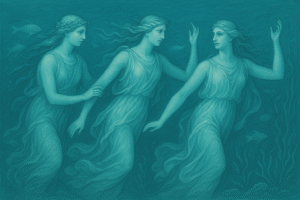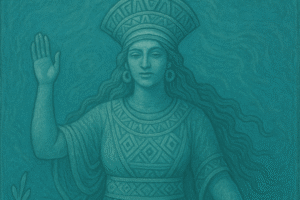From Ancient Greece to Chinese Medicine
Water as a Therapeutic Element
From Hippocratic medicine and Greek water deities, to Qucha Mama in the Andes and Asian goddesses of rivers and lakes, the Water element embodies purification, flow, and renewal. In Chinese medicine, Water connects us to the kidneys and bladder, the energetic foundation of life itself. Through hydration, herbs, colors, scents, and meditative practices, we can restore balance to the Water element within us and support both body and spirit.
The Water Element in Hippocratic Medicine
Hippocrates, the father of medicine, described health as the balance of the four humors:
Blood
Phlegm
Yellow bile
Black bile
Water was closely associated with phlegm, representing coldness, moisture, and fluidity.
When in balance, Water granted calmness, adaptability, and vitality. When imbalanced, it could manifest as sluggishness, respiratory conditions, excess mucus, or emotional stagnation.
Water and Healing in Ancient Greece
For the Greeks, healing sanctuaries often emphasized purification rituals involving water, such as bathing in sacred springs or rivers. Water symbolized cleansing both body and spirit, removing illness and restoring balance.
The Water Element in Chinese Medicine
In Traditional Chinese Medicine (TCM), Water is one of the five elements (Water, Earth, Fire, Wood, Metal). It governs the kidneys and bladder, which control life force (Jing), reproductive health, and the regulation of bodily fluids.
When balanced:
Energy feels replenished and adaptable.
The mind is calm, resilient, and intuitive.
The body maintains proper hydration and fluid balance.
When imbalanced:
Fear and anxiety dominate.
Lower back pain, urinary issues, or reproductive weakness arise.
Fatigue, dry skin, or brittle bones may appear.
Water Element and Healing
Water represents adaptability, cleansing, and renewal. Just as rivers carve valleys and springs give life, the Water element sustains and purifies. Nurturing the Water element supports longevity, emotional balance, and physical vitality.
Colors, Smells, and Practices to Support the Body’s Water Element
Colors: Blue, black, and deep indigo resonate with Water. Surrounding oneself with these tones cultivates calmness and fluidity.
Smells: Fresh and aquatic aromas such as eucalyptus, peppermint, rosemary, and lotus bring balance to Water energy.
Practices & Meditation:
Gentle flowing movements such as Tai Chi or Qi Gong, symbolizing water’s adaptability.
Meditation with imagery of rivers, oceans, or flowing streams.
Relaxing baths or hydrotherapy for cleansing and renewal.
Deep breathing exercises, visualizing inhaled air as flowing water purifying the body.
Foods, Herbs, and Oils that Support the Water Element
Foods:
Seaweed, fish, shellfish
Black beans, kidney beans
Dark-colored fruits (blueberries, blackberries)
Seeds and nuts (especially walnuts and sesame)
Herbs & Oils:
Adaptogenic herbs like ginseng and ashwagandha
Licorice root, nettle, and rehmannia (in TCM)
Essential oils: sandalwood, rosemary, and juniper berry
Water Goddesses and Deities in World Mythology
Greek Nereids – Sea Nymphs of Healing
The Nereids were sea goddesses who guided sailors, protected waters, and symbolized fertility and healing through the ocean’s life-giving power.
Qucha Mama – Andean Protector of Water
In the Andes, Qucha Mama (“Mother of the Lake”) was revered as the goddess of water. Ritual offerings to her were made to ensure rain, fertility, and healing of the land and people.
Asian Water Deities
Across Asia, water goddesses embody purification and fertility. In Hindu tradition, Ganga, the goddess of the River Ganges, represents purity and liberation. In East Asia, water spirits are guardians of rivers and rain, essential for crops and health.
The Water Element Q&A’s
1. What does the Water element symbolize in Hippocratic medicine?
It was linked to phlegm, representing fluidity, calmness, and purification. Balance brought vitality, while imbalance caused stagnation and illness.
2. Which goddess represents Water in mythology?
The Nereids in Greece, Qucha Mama in the Andes, and Ganga in India represent purification, healing, and fertility.
3. How is the Water element understood in Chinese medicine?
It governs the kidneys and bladder, storing vital energy (Jing) and regulating fluids.
4. How does the Water element support healing?
It provides adaptability, calmness, emotional cleansing, and physical vitality.
5. What foods strengthen the Water element?
Seaweed, fish, black beans, walnuts, and dark-colored fruits.
6. Which herbs and oils are good for the Water element?
Nettle, licorice root, ginseng, and essential oils like rosemary and juniper.
7. What colors and smells balance the Water element?
Deep blues and blacks, combined with aquatic and herbal scents such as eucalyptus or lotus.
References / Bibliography
Unschuld, P. (1985). Medicine in China: A History of Ideas. University of California Press.
Leiden University Student Depository. The role of Water in Greek Sanctuaries
Eck, D. (1982). Banaras, City of Light (on Ganga). Columbia University Press
Hippocrates. On the Nature of Man. Translations and studies on the four humors and elements.
Jouanna, Jacques. Hippocrates. Johns Hopkins University Press, 1999.
Kaptchuk, Ted J. The Web That Has No Weaver: Understanding Chinese Medicine. McGraw-Hill, 2000.
Vlachou Panagiota Sophia
Certified Beekeeper | Specializing in Traditional Beekeeping & Natural Wellness Methods
Trained in Traditional Acupuncture – Academy of Traditional & Chinese Medicine
Member of the Beekeepers’ Association of Attica-Greece
Disclaimer: This article is for educational and informational purposes only. It is not intended to diagnose, treat, cure, or prevent any disease, and it does not substitute professional medical advice. Always consult a qualified healthcare professional before making any changes to your diet, lifestyle, or health practices.





